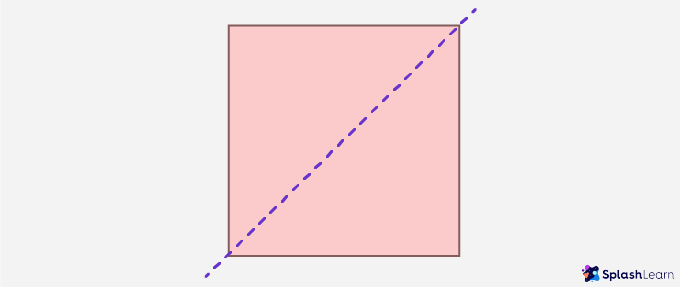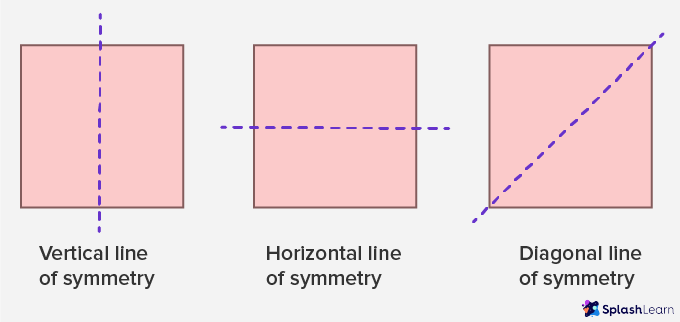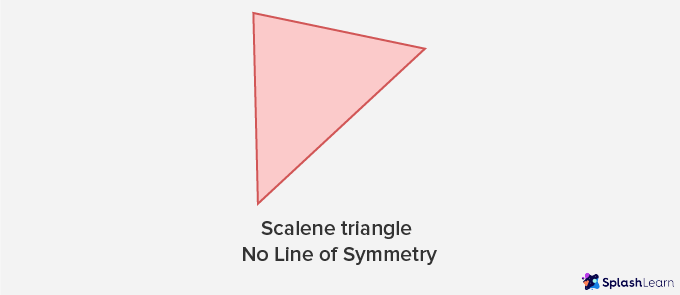Symmetry
In mathematics, especially in geometry and its applications, an object is said to have symmetry if it can be divided into two identical halves. For example, look at the given picture of a flower:

If we were to draw an imaginary line in the middle of it, we could divide it into two equal parts like this:

Note that the two parts are identical and mirror images of each other.
An object that is not symmetric is said to be asymmetric. That means that an asymmetric object cannot be divided into identical halves.
An example of asymmetry would be the given image.

Recommended Games
Line of Symmetry

Let’s look at this flower again, the dotted line along which we divided it into two identical halves is called the line of symmetry or the axis of symmetry. It can also be defined as the line along which we can fold the object and its left and right half would completely overlap with each other.
In mathematics, there are three types of lines of symmetry.
- The Vertical Line of Symmetry
- The Horizontal Line of Symmetry
- The Diagonal Line of Symmetry
Let’s take a look at each of these lines.
Vertical Line of Symmetry
A vertical line that divides an object into two identical halves is called a vertical line of symmetry. That means that the vertical line goes from top to bottom (or vice versa) in an object and divides it into its mirror halves. For example, the star below shows a vertical line of symmetry.

The Horizontal Line of Symmetry
When a horizontal line divides an object into two identical halves, it is called a horizontal line of symmetry. That means the horizontal line of symmetry goes from left to right (or vice versa) in an object. For example, the image below shows a horizontal line of symmetry.

The Diagonal Line of Symmetry
When a diagonal / skew line divides an object into two identical halves, it is called a diagonal line of symmetry. For example, the square below shows a diagonal line of symmetry.

In fact, a square possesses all three lines of symmetry.

So we can say that an object can have multiple lines of symmetry. Some other examples of shapes that have multiple lines of symmetry are circles and rectangles.
An example of a shape that does not have any line of symmetry is a scalene triangle. Since all sides of a scalene triangle are different, it cannot be divided into two identical mirror halves.

Symmetry in Real Life
Symmetry was taught to humans by nature itself. A lot of flowers and most of the animals are symmetric in nature. Inspired by this, humans learned to build their architecture with symmetric aspects that made buildings balanced and proportionate in their foundation, like the pyramids of Egypt! We can observe symmetry around us in many forms:
- Trees reflected in crystal clear water and towering mountains reflected in a lake.
- The feathers of a peacock and the wings of butterflies and dragonflies have identical left and right sides.
- Hives of honeybees are made of hexagonal shape, which is symmetric in nature.
- Snowflakes in winter have all three lines of symmetry.
Solved Examples on Symmetry
Example 1: How many lines of symmetry does the given figure have?

Answer: Only one line of symmetry.

Example 2: Can you find any examples of letters from the alphabet that have a horizontal line of symmetry?
Answer: A lot of letters, like O, D, H, have horizontal lines of symmetry.
Example 3: Is the given shape symmetric or asymmetric?

Answer: The given shape is symmetric with a vertical line of symmetry.
Practice Problems on Symmetry
Symmetry
How many lines of symmetry does a rectangle have?
A rectangle has only two lines of symmetry.

Which of the following letters of the alphabet have a horizontal and vertical line of symmetry?
The letter X has both vertical and horizontal lines of symmetry.
Which line of symmetry does the following figure have?

The given figure only has a vertical line of symmetry
Which of the following numbers has two lines of symmetry?
The number 8 has two lines of symmetry.
Frequently Asked Questions on Symmetry
What is symmetry in math?
Symmetry in math is the property of an object to be able to be divided into two identical mirror halves.
What is the axis of symmetry?
The axis of symmetry is defined as the imaginary line along which an object can be folded or be divided into two identical mirror halves.
How many lines of symmetry are there?
There are three lines of symmetry, namely the horizontal line of symmetry, the vertical line of symmetry, and the diagonal line of symmetry.
How many lines of symmetry does a circle have?
A circle can be divided into two identical halves by folding it along its diameter. Since a circle has infinite diameters, it has infinite lines of symmetry.


















